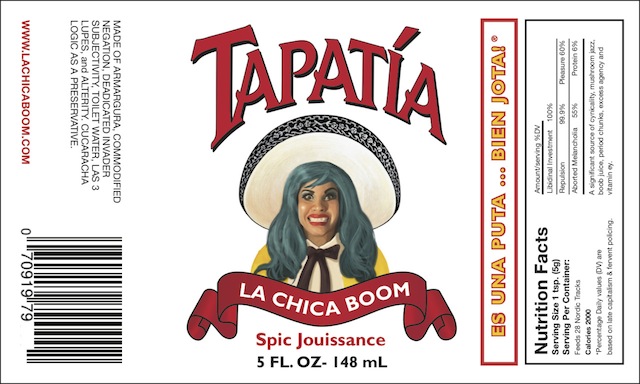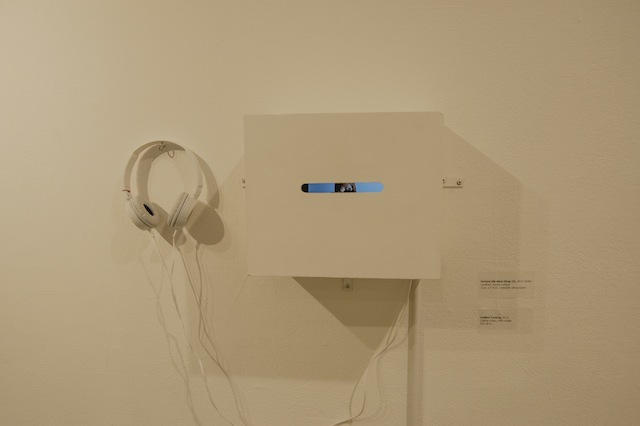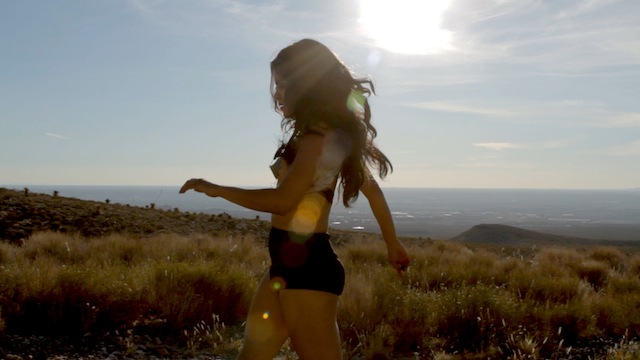A giant cucaracha (cockroach), made of velvet, glitter and synthetic fur, inhabits the center of Galería de la Raza for Xandra Ibarra’s solo exhibition Ecdysis: The Molting of a Cucarachica. The cucaracha, and its inclination towards metamorphosis, symbolizes the transformations, hidden personas and double meanings found in Ibarra’s work, which bluntly and humorously addresses racial stereotypes and their overt sexualization.
A number of videos in the exhibition draw on Ibarra’s burlesque alias La Chica Boom. Spictacle II: Tortillera (2015) features a woman in a traditional Mexican dress who dances for the camera while flipping corn tortillas. A tortillera is a person who makes and sells tortillas, but it is also slang for a lesbian. And as the woman sheds her bulky dress, she dispenses with the restrained persona of the tortilla maker. Using layers of her own undergarments, she makes a taco with black lingerie and another with Mexican flag underwear. The woman strips further to reveal an unorthodox repurposing of a hot sauce bottle (rebranded “Tapatía”), used in a final ritualistic action over the decidedly inedible tacos.

Forgoing the iconic sombrero-wearing gentleman of Tapatío, the corporate mascot on Ibarra’s bottle is modeled after La Chica Boom, with blue hair and eyeshadow and a teeth-baring grin. Several dozen bottles of this sauce are installed on wooden shelves throughout the gallery. The label seems to caution against using the hot sauce, as it allegedly includes ingredients such as “commodified negation” and toilet water. However, with “cucaracha logic” as a preservative and 60% of the daily recommended serving of pleasure, maybe a little taste wouldn’t hurt.

A peepshow next to the hot sauce array features a video piece called Untitled F**king (2013) made in collaboration with artist Amber Hawk Swanson. Set up like a webcam shoot, Ibarra wears her Tapatía bottle while positioned behind Swanson, who lays on a bed repeating, “Feminism? That’s deep. I think I need a minute to think about that, so… I don’t know.” The 15-minute video uses what Ibarra calls “queer sexual vocabulary” to probe and poke at the limitations and conflicts within feminism, including the relationship between white feminists and feminists of color.

The three-minute video La Corrida (2012) is activated by viewers running on a treadmill in front of a projection screen. In the piece, Ibarra wears black leather boots, lingerie and pasties while jogging on streets and through dirt. She runs with an intensity and sense of purpose that suggest something other than exercise, but she does not appear to be frightened or fleeing. Her trail is the Juárez–El Paso border, a site infamous for decades of violence against women, as well as a symbol of NAFTA and free trade. With resilience, Ibarra tackles this contentious, sun-soaked terrain.
The cucaracha is seen in some photographs, jewelry and installations, but it is not always explicitly present, appearing only in ideas and interpretations. Though the insect is almost universally loathed, it is — in this exhibition — a noble creature. Its strength and perseverance are enviable, and its constant rebirth might just be an example worth following. Ibarra channels these attributes playfully — possibly the only way to channel the cucaracha — but she does so incisively and critically.